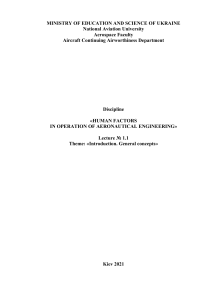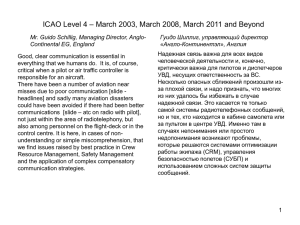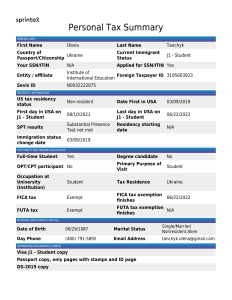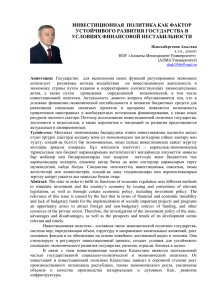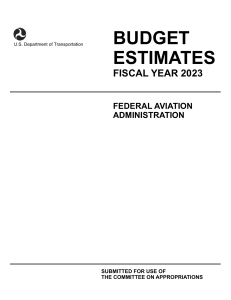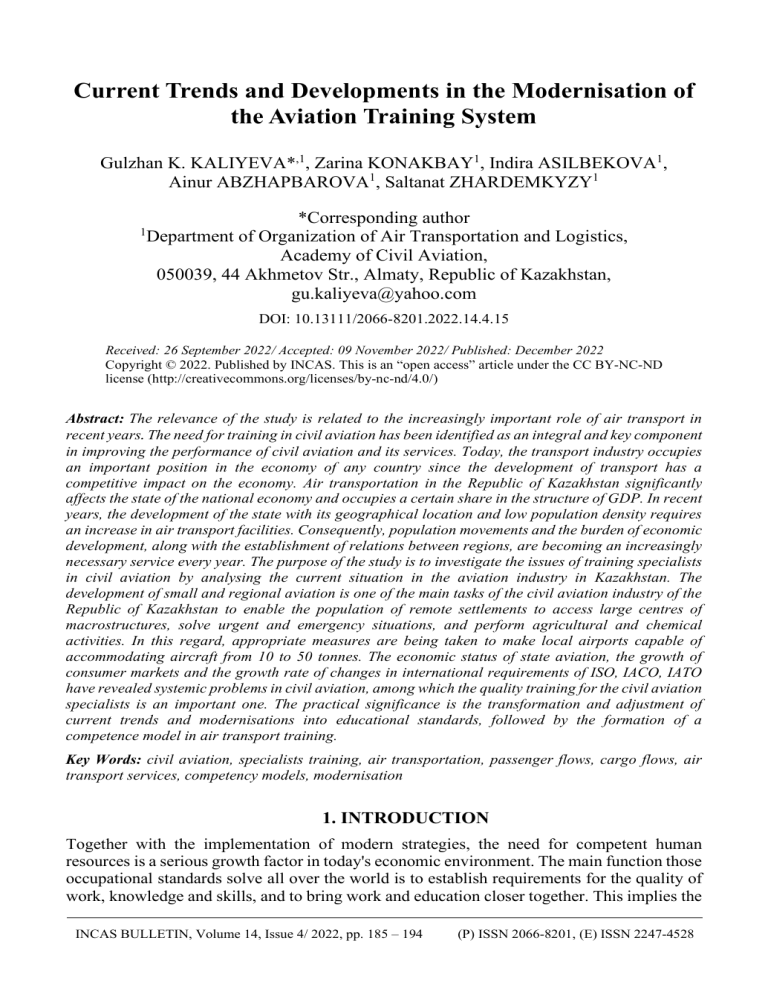
Current Trends and Developments in the Modernisation of the Aviation Training System Gulzhan K. KALIYEVA*,1, Zarina KONAKBAY1, Indira ASILBEKOVA1, Ainur ABZHAPBAROVA1, Saltanat ZHARDEMKYZY1 1 *Corresponding author Department of Organization of Air Transportation and Logistics, Academy of Civil Aviation, 050039, 44 Akhmetov Str., Almaty, Republic of Kazakhstan, gu.kaliyeva@yahoo.com DOI: 10.13111/2066-8201.2022.14.4.15 Received: 26 September 2022/ Accepted: 09 November 2022/ Published: December 2022 Copyright © 2022. Published by INCAS. This is an “open access” article under the CC BY-NC-ND license (http://creativecommons.org/licenses/by-nc-nd/4.0/) Abstract: The relevance of the study is related to the increasingly important role of air transport in recent years. The need for training in civil aviation has been identified as an integral and key component in improving the performance of civil aviation and its services. Today, the transport industry occupies an important position in the economy of any country since the development of transport has a competitive impact on the economy. Air transportation in the Republic of Kazakhstan significantly affects the state of the national economy and occupies a certain share in the structure of GDP. In recent years, the development of the state with its geographical location and low population density requires an increase in air transport facilities. Consequently, population movements and the burden of economic development, along with the establishment of relations between regions, are becoming an increasingly necessary service every year. The purpose of the study is to investigate the issues of training specialists in civil aviation by analysing the current situation in the aviation industry in Kazakhstan. The development of small and regional aviation is one of the main tasks of the civil aviation industry of the Republic of Kazakhstan to enable the population of remote settlements to access large centres of macrostructures, solve urgent and emergency situations, and perform agricultural and chemical activities. In this regard, appropriate measures are being taken to make local airports capable of accommodating aircraft from 10 to 50 tonnes. The economic status of state aviation, the growth of consumer markets and the growth rate of changes in international requirements of ISO, IACO, IATO have revealed systemic problems in civil aviation, among which the quality training for the civil aviation specialists is an important one. The practical significance is the transformation and adjustment of current trends and modernisations into educational standards, followed by the formation of a competence model in air transport training. Key Words: civil aviation, specialists training, air transportation, passenger flows, cargo flows, air transport services, competency models, modernisation 1. INTRODUCTION Together with the implementation of modern strategies, the need for competent human resources is a serious growth factor in today's economic environment. The main function those occupational standards solve all over the world is to establish requirements for the quality of work, knowledge and skills, and to bring work and education closer together. This implies the INCAS BULLETIN, Volume 14, Issue 4/ 2022, pp. 185 – 194 (P) ISSN 2066-8201, (E) ISSN 2247-4528 G. K. KALIYEVA, Z. KONAKBAY, I. ASILBEKOVA, A. ABZHAPBAROVA, S. ZHARDEMKYZY 186 high relevance of solving problems related to civil aviation training and the creation of a specialised innovative educational cluster as an integral and key component to improve the efficiency of civil aviation and services [1]. In this respect, civil aviation training is oriented toward the main lines of development of aviation activities: growth of the air transport services market; rising competition in the transport market; increasing requirements for the quality of the air transport system and service in general. Infrastructure and the environment define new tools to facilitate and develop the system of training aviation specialists. In addition, they leave freedom of management in the development of regional airports, locally influencing the development of technical systems and air traffic services, and public policy for the aviation sector designs operational programmes for civil aviation investment projects [2]. The observed dynamism of air transport is contributing to changes in the system of strategic documents at a national level and work on the rationale behind the contextual factors for training aviation professionals, which in turn will drive a new financial perspective. The current trends and tendencies in the modernisation of the aviation training system are not only an update of government policies and programmes but also a focus on identifying new problems that need to be properly addressed to ensure sustainable, adapted to external and internal conditions and needs, development of civil aviation [3]. This development must nonetheless account for not only the size of the airport infrastructure, the capacity of the airspace, and the efficiency of their use, but also the influence of other market players. Aviation training includes areas such as environmental protection, civil aviation safety, aviation market regulation, financing, investment, international policy, bilateral relations and general aviation human resources policy. Aviation policy, which defines the directions and framework for the development of aviation at the strategic level, serves as a guide for airport managers regarding the training of specialists. Modern trends and directions of modernisation contribute to the collection of innovative funds and, therefore, with the help of an integrated approach, ensure the emergence of a synergetic effect in terms of management and training of aviation specialists at the state level of an integrated transport system, the main attributes and distinctive features of which are modality and sustainable development. At the initial stage of creating Kazakh aviation personnel, didactic training applies well-known modern methods of schools in Austria, Russia and Germany. Candidates for aviation undergo a medical examination that confirms their predisposition to psychophysical tasks in the air. However, the real breakthrough in aviation training is the modern training organisation of specialists both on the ground and in the air [4]. Education and training in the air remain a long and expensive process, which requires compliance with safety regulations for all aviation tasks. At all stages of training, the correctness of the methods and means used in preparation is evaluated. The basis of successful learning is the psychophysical component, which makes it easier to assimilate knowledge and uses simpler methods of knowledge transfer. Potential employers in the civilian labour market include: the air transport sector, i.e., airlines, traditional and lowcost, charter services, air taxi services; airports, aircraft repair plants and other aviation enterprises, the commercial aviation sector, which includes all types of flights for economic needs [5; 6]. The purpose of the study is to investigate the issues of training specialists in civil aviation by analysing the current situation in the aviation industry in Kazakhstan. INCAS BULLETIN, Volume 14, Issue 4/ 2022 187 Current Trends and Developments in the Modernisation of the Aviation Training System 2. MATERIALS AND METHODS The methodological basis of the study is modular competency, integration, and monitoring research methods. The modular-competent method is associated with a modular training programme for aviation specialists. A module is understood as an independent unit of the curriculum consisting of smaller units comprising logical and practical work whose individual elements are thematically integrated with different areas of science and whose training content expresses intellectual skills, i.e., cognitive, content and emotional. The modules that specialists work on are topics related to professional competencies and tolerance. In addition to an integrated training system, specialists participate in projects that allow them to receive funds for their activities. An important element of this approach is to consider training as a process consisting of a gradual approach to knowledge, based not only on theoretical knowledge of the facts but also on the ability to search these facts and to analyse, interpret and reflect on them. This activating method of teaching is more effective in combining theory with practice and knowledge with specific skills. The integration approach implies that the functioning of any training of aviation specialists requires coordinated and orderly cooperation of many cells and organisational units. Often it is more than one concept pursuing shared goals, or several independent strands working in the same chain to create a modern and modernised domestic system. As practice shows, various functions and areas of training implement their tendencies independently of each other, without coordinating the relationships and dependencies between them. As a result, the system looks orderly, but in practice, it causes a lack of consistency between individual process solutions, which causes a number of misunderstandings between the various functions of training aviation specialists. Their goal is to combine all methods and structures of innovative training using a process approach into a single coordinated aviation system. This applies both to aspects of the management of the entire organisation, and to individual processes and resources – material, human, and information. The current methodology creates an open set of processes and adapted regulations for a process management structure that forms the basis for the integration of actions into processes. The monitoring paradigm focuses on the infrastructure and tools that meet the current needs and requirements of a modern aviation training system. It allows the selection of solutions that will work harmoniously with the existing infrastructure and fit into long-term plans for the development of the training structure in the Republic of Kazakhstan. This methodology analyses strategic plans, financial goals and the most important processes related to the processing of aviation information, and then develops a practical aspect to achieve common goals. At this stage, realistic measures and key indicators of the effectiveness of training specialists are determined, by which the success of the activity is measured. Using tracking tools, the effectiveness of current trends and developments in the modernisation of the domestic system of training aviation specialists is measured, allowing the continuous improvement of technology and the introduction of new solutions for the development of the training structure. The monitoring approach is currently considered one of the most important directions in the field of training and management of modern organizational units, which implies continuous improvement not only of individual processes but also of the whole system. 3. RESULTS AND DISCUSSIONS According to many statistics, air transport is considered the safest way to travel. In aviation, safety is understood as a condition in which the possibility of injury or material damage is reduced and maintained at an acceptable level through a continuous process of identifying INCAS BULLETIN, Volume 14, Issue 4/ 2022 G. K. KALIYEVA, Z. KONAKBAY, I. ASILBEKOVA, A. ABZHAPBAROVA, S. ZHARDEMKYZY 188 hazards and managing risks to flight safety. To achieve the goal of safe transportation in aviation, a variety of mechanisms has been developed that constitutes the civil aviation safety management. The vast majority of them are based on specific provisions that are designed to guarantee the development of a safety management system. Conducting training of aircrew members to obtain a flight crew member qualification certificate and permits entered therein, except the conduct of flight training for the purpose of obtaining a flight crew member qualification certificate, may be carried out by an entrepreneur, including from another state that carries out economic activities in accordance with the regulations in force in that country, and temporarily offers or provides a service in the territory of Kazakhstan that declares that the performance of the activities included in the training registry does not endanger the safety of air traffic or public order. The organisation of training for air traffic services personnel is an element of the competency framework. Air transport has always been associated with the risk of an accident. However, for more than a hundred years of aviation development, this risk has been minimised to such an extent that today air transport is the safest means of transportation. This state of affairs is above all the merit of the technical and organisational progress of specialists in aviation. The economic benefits of using the aircraft contribute to the introduction of new and advanced machines and devices, and to the development of aviation infrastructure that increases the level of safety and training of aviation personnel [7]. There are rules of an administrative nature in aviation in the area of human resources regulation. They regulate in great detail the principles for starting and operating an aviation business. The fundamental role of the system of legal norms in aviation law, on the one hand, is very extensive, and on the other hand, it often imposes rather general requirements on aviation organisations. Aviation law norms by their nature rarely pay attention to the variety of conditions in which aviation enterprises operate. Thus, the pursuit of more detailed legal provisions brings with it the risk of creating overly complex and ineffective regulations. Therefore, there is a continuous development of precisely those regulations that are associated with the adoption of preventive measures. In the broadest sense, this is about security management, collecting information about existing threats, which are important to consider in the process of training aviation specialists. The requirement to introduce modern trends and developments in the modernisation of the national aviation training system acts as an element of safety management at the national and supranational levels. Aviation, by its very nature, is an international activity. That is why international rules are of fundamental importance for regulations related to air navigation. They are designed to facilitate and improve the international air navigation of specialists by international safety standards and recommendations. Such standards are mandatory when aviation regulations are put into effect, guided by the principles of compliance with international rights [8; 9]. Civil aviation is developing dynamically. The average annual growth in the number of air traffic and the number of passengers transported remains at a high level. The overall increase in the preparatory work of specialists leads to the retention of the intended goals, a sufficient level of safety in terms of the index of the relative number of accidents. Reducing accidents and losses entails efficiency in transporting passengers, cargo and mail over long distances, along with protecting the global economy from disruptions caused by the global air transport crisis for optimal future development of aviation. As a result, current trends in the modernisation of the aviation training system focus primarily on safety, which contributes to the optimal development and smooth functioning of the system. Analysing the economic situation of the aviation industry in Kazakhstan, it should be noted that in recent years the importance of air transport has increased. This is evidenced by the growth of passenger traffic on air transport. In 2019, the revenue for the first half of the INCAS BULLETIN, Volume 14, Issue 4/ 2022 189 Current Trends and Developments in the Modernisation of the Aviation Training System year was KZT 166.2 billion, rising by KZT 23.8 billion compared to 2018. According to the Statistics Committee of the Ministry of National Economy of the Republic of Kazakhstan, based on January-July 2019 results, the total revenue of air transport companies was KZT 216.7 billion, indicating an 18.6% increase in revenue compared to the same period in 2018. The main source of revenue for airlines is passenger traffic, mainly due to the opening of additional routes and new airlines. At the same time projects of various state programs until 2025 provide for the construction and reconstruction of local airports, such as Pavlodar region – Bayanaul, East Kazakhstan region – Urjar, Zaisan, Ulken-Naryn, Almaty region – Usharal, West Kazakhstan region – Zhanibek, Saikhin, Kaztalovka, Atyrau region – Kulsary, Miyaly, Suyundik, Karaganda region – Karkaralinsk, Ulytau, Turkestan region – Saryagash, Kostanai region – Arkalyk, Aktobe region – Shalkar. Also, the management of Kazakhstani aviation companies has completed the establishment and expansion of flights to priority destinations in more than 30 countries of the world (Figure 1) [10; 11]. Figure 1. Long-term passenger traffic forecast The current trend in the legal norms of aviation security suggests that it is at the level of an aviation organisation that a safety management system should be created and implemented, which will be used by a specific entity, allowing preventive actions to be taken in the event of a specific threat being identified. The purpose of flight safety management is the continuous implementation of measures to ensure maintenance at an acceptable level. Aviation safety management is considered an organised approach to solving flight safety issues at the international, national and organisational levels. However, even the most advanced international or national solutions have a greater impact on safety if personnel training and transport organisation are not implemented productively. The system of training aviation specialists is designed to draw attention to a specific aviation organisation that has the appropriate resources – personnel, time, money, in case of adverse events that may occur. The innovative form of training includes the adoption of corrective actions to prevent undesirable events: incident-free air travel; maximum reduction of human losses; safety-oriented activities of all employees of this organisation; extensive use of risk management principles. There is a clear correlation between the number of trips and the GDP value for a given country. The expansion of travel opportunities contributes to the development of the economy, and the ability to connect to a preparatory hub is an accepted measure of communicative accessibility for society and the assessment of mobility. The purpose of the preparatory procedures is to create an opportunity for cooperation, which in turn helps to neutralise human weaknesses and maximise the talents and strengths of INCAS BULLETIN, Volume 14, Issue 4/ 2022 G. K. KALIYEVA, Z. KONAKBAY, I. ASILBEKOVA, A. ABZHAPBAROVA, S. ZHARDEMKYZY 190 the participants. It is a set of actions, including planning and decision-making, organisation, management, supervision of people, aimed at the organisation's resources – human, financial, material and information – carried out to achieve the organisation's goals most productively and efficiently. Over time, the diversification of tasks and the increasing complexity of the production process has meant that each industry and type of organisation requires new solutions, training and methodologies. Universal theories and approaches to training are impossible, therefore, theorists and practitioners develop achievements by clarifying the basics of methodology. Recently, information, human resources, processes, projects and systems have been managed. The development and objectivity of aviation training provide a different perspective on activities aimed at improving aviation safety in the training category. Using knowledge of a wide range of relevant definitions, this process makes it possible to understand its objectivity, purposefulness and subjectivity, because training is a set of management measures, including the establishment of specific policies and objectives, along with ensuring safety to reduce risks related to aviation activities to an acceptable level [12; 13]. Of particular importance are civil aviation training activities that investigate the effective airline performance, which influence the implementation of the government's education strategy. The most relevant criteria have been identified, among which are: the proportion of employees who have received training, internships; the number of financial resources spent on employee training. Therefore, employee training is one important aspect of improving a company's performance in civil aviation. For example, Air Astana provides AB-Initio training in accordance with US and European standards with intensive training for 2 years followed by the issuance of a Frozen ATPL top pilot licence. Only 15 people are trained during the year, as the high cost of tuition means that many cannot afford to enrol in the programme. Connecting the regions is crucial for the economic interests of the state and the creation of new job opportunities. Every job in aviation creates three new jobs in other sectors of the economy. Aviation supports the development of global merchandise trade by up to 35% [14]. The main task of modern developments is training as part of civil aviation security vocational education – of both employees of aviation companies and specialised formations to work as operators of the security control service. Using the evolution of ideas about flight safety, it is easy to see that the classical approach excludes the issue of risk reduction and substitution, which would reduce the number of aviation accidents. The training of aviation specialists is determined differently by international and state aviation organisations. Also, scientists and aviation experts give different definitions and models, indicating a different approach to current activities. It is due to the exceptional scope of correct flight operations and the absence of threats that can cause negative consequences in the form of accidents and related damage. Using a categorisation of sorts, it can be stated that specialist training is characterised by: ensuring that air operations performed are not compromised, i.e., the flight process itself is controlled and maintained at an acceptable level; absence of accidents and hazards; avoidance of losses; specialist attitude towards hazardous activities and conditions; error avoidance; compliance with regulatory requirements. All measures make it possible to minimise the consequences of unplanned situations by using appropriate systems that protect the health and life of people on board the aircraft. Incorrectly installed preparation tools that transmit ambiguous information cause difficult errors in the automatic function activation system. The rules and procedures for training specialists best reflect the approach to safety in an era of technological and human revolutions. Given the delay in legislative aspects, in particular, the creation of international law and its implementation into the national legislation of the country, it can be stated that any decision can be postponed even for several years due to the impact of new emerging threats [15; 16]. INCAS BULLETIN, Volume 14, Issue 4/ 2022 191 Current Trends and Developments in the Modernisation of the Aviation Training System The modern model of training aviation specialists defines five elements that are the main ones in the construction of an aviation system: the type of equipment used and its reliability, functionality, ergonomics; the person who participated in the flight: first of all, pilots, flight attendants, as well as air traffic controllers, mechanics, ground attendants and all other persons who directly or indirectly affect the performance of air operations; the environment in which the flight will be performed: weather, geographical location, infrastructure, time of day, time of year and other conditions; the task to be performed; the management of the aviation organisation: procedures, security policy, available forces and resources, workload. Such a model is the simplest structure of an aviation system, so it is easy to use it for quick and preliminary analyses, the appearance of which depends on many factors causing the effect of proportions. After all, each flight is different because it takes place in different circumstances and operational reality – each flight differs in weather, time, the health of the pilot, the technical condition of the aircraft, flight parameters. By making the same mistake, the operational reality can lead to different consequences or their absence. Having noticed this, it is important to contribute to the modern and promoted aviation training system by considering the issue very broadly, considering all the elements affecting the reality of the operational scale of impact (Figure 2). Figure 2. Level of training (initial training institution) of pilots of AON aircraft with which aviation accidents occurred Since the beginning of man's interest in aviation, one can see the attention he has paid to various aspects of air operations to ensure his safety. These interests are focused on the main threats and causes of aviation accidents in a given period [17]. Accordingly, the interaction with the software plays an important role in the training process, where the most important thing is to influence aviation personnel through appropriate procedures, aviation law, and training and selection. Procedures that should be useful in normal and emergency situations should be unambiguous, legible and easy to implement. Following them is a guarantee of the proper performance of the task, without missing, forgetting, or violating any element of the activity. It should also be noted that these exercises are completely convincing in their importance and in ensuring that they are properly executed without disruption. Aviation law, in particular, the definition of the principles of licensed personnel, certification and continuous supervision establishes requirements that must be met in compliance with certain safety standards. Human-machine interaction makes it easier to use and read information and increases tool ergonomics, ease of use and general comfort. Emergency alarm system skills focus all attention on the detected problem, and the principle of automation is increasingly being used in the training of aviation professionals. INCAS BULLETIN, Volume 14, Issue 4/ 2022 G. K. KALIYEVA, Z. KONAKBAY, I. ASILBEKOVA, A. ABZHAPBAROVA, S. ZHARDEMKYZY 192 Modern elements and components of the aviation preparatory system create an individual operational reality. Focusing on individual cases makes it difficult to identify common problems that synthesise knowledge, including accident findings. Consequently, it emphasises the fact that aviation is a highly complex system with many elements connected by a dense network of interdependencies. In addition to technical and human factors, there is also a systemic, i.e., organisational, factor that may itself be a major cause of inadequate national training [18]. The systematic approach is aimed at eliminating errors generated by a constantly imperfect system. These errors may pose a threat to flight safety. Traditional methods of improving safety add new methods consisting of routine data collection and analysis from inside and outside the organisation, which may indicate the occurrence of precursors of accidents, i.e., hidden threats. Failure to understand all the potential safety risks in air operations will not further enhance competence and professionalism. Using the available developments of scientists and specialists, it is necessary to try to anticipate the threats that may yet arise. By establishing appropriate policy structures, security procedures and making the responsibility of trained personnel clear, it is possible to respond to existing and possible threats and to anticipate them before they become active [19]. The aviation training system is a changing system. Its changes are caused by the development of aviation and its elements, such as equipment, infrastructure, improvement of legislation, contributing to the evolution within the operational reality in which the aviation system operates. The internal and organisational culture of an aviation organisation is conditioned by the personnel directly involved in air operations, which is characterised by knowledge, skills, experience, judgement, and by capabilities and cooperation within the flight crew [20]. An aviation specialist must possess the following features: physical health, including vision, hearing or height, range of action, age; ability to withstand overload, motion sickness; ability to determine their position in space; a sense of balance; mental health, absence of possible phobias and fears, problems with concentration, separation of attention, emotions; knowledge, experience, skills. This also includes support personnel who perform air operations, including flight attendants, air traffic controllers, mechanics, ground handling personnel, trainers, aviation unit inspectors and others. These people are also treated according to the categories described above. Above all, all elements work together in the flight process to create optimum conditions. This system is based on people who are influenced by other groups of elements, interacting with them in a certain way [21]. The modernised preparatory directions and procedures should be useful in unforeseen situations, unambiguous, legible and easy to implement. Following them is a guarantee of the proper performance of the task, without missing, forgetting, or violating any element of the activity. A high level of management of an aviation organisation determines the goals of the organisation, strategy and policy, as well as allocates forces and resources to achieve the goals and objectives set. Systems that replace or support preparatory activities provide analysed information and signal the adoption of appropriate decisions. As a result, one error does not immediately give negative effects, because it is picked up by another barrier. This is how an ideal system should function, but there is no such system. In fact, there are many shortcomings at the levels described, which are emblematic of the deficiencies at each level of aviation training. A large number of these deficiencies, due to errors or lack of defence systems, can result in most of the threats described being hidden, so that they only appear with a certain overlap, which usually develops over time. Dangerous actions occurring inside or outside an organisation forces it to adapt to a particular environment in which the possibility of harm to people or property is reduced and maintained at an acceptable level or becomes lower by introducing a continuous process of hazard identification and safety risk management into the training system [22; 23]. INCAS BULLETIN, Volume 14, Issue 4/ 2022 193 Current Trends and Developments in the Modernisation of the Aviation Training System 4. CONCLUSIONS Thus, there is currently an imbalance between labour supply and demand in the Republic of Kazakhstan, which leads to a lack of qualified specialists and a lack of interaction between education and the real sector of the economy. The solution to these issues is to improve knowledge and skills that determine the qualifications of civil aviation professionals, especially in terms of assessing their strategic focus and knowledge, and modern decisionmaking methods. This approach to training is even more significant as the competencies of civil aviation professionals include aspects of airline operations. Developing the competencies of aviation specialists is of paramount importance, and close cooperation with leading foreign research centres and aviation companies is necessary here, which determines the need for specialists and the training of personnel capable of solving practical problems. From the proposed recommendations, it is advisable to form a competency model for civil aviation specialists and establish a certification centre to certify qualifications. Improving the efficiency and quality of the air transport system will depend more on the level of training of qualified personnel using the competence model. For the Republic of Kazakhstan, the training and retraining process for civil aviation personnel should include a defined training programme with developed competencies oriented towards compliance with European directives. Given the catastrophic shortage of qualified specialists in the labour market, building a system of competent aviation specialists becomes the basis for solving human resource capacity issues. Since the requirements of ISO, IACO, IATO and Frozen ATPL to the level of knowledge, skills and competence are applicable to improve aviation safety and flight safety, presented solutions to problems of domestic companies using a competence model based on the analysis can offer changes and additions to educational standards in air transport education, considering the specifics of air transport and the training of flight, dispatch and engineering specialists in the educational structures of aviation of the Republic of Kazakhstan. These include: identification of training aircraft and training flights in educational institutions; training of specialists following the requirements of the civil aviation personnel roster; development, enforcement and compliance with aviation regulations in civil aviation educational institutions; development and implementation of educational programmes in civil aviation training by international requirements. REFERENCES [1] W. Coyne, A review and history of the air traffic-collegiate training initiative program, International Journal of Aviation, Aeronautics and Aerospace, 12, 1045-1053, 2019. [2] E. K. Faulconer, B. Wood, J. C. Griffith, Infusing humanities in STEM education: Student opinions of disciplinary connections in an introductory chemistry course, Journal of Science Education and Technology, 1(6), 87-96, 2020. [3] S. G. Fussell, D. Truong, Preliminary results of a study investigating aviation student’s intentions to use virtual reality for flight training, International Journal of Aviation, Aeronautics and Aerospace, 24, 701-709, 2020. [4] K. Stefanski, Assessment of professionally important qualities aviation technical staff, AIP Conference Proceedings, 13(2), 136-144, 2019. [5] D. McGunagle, L. Zizka, Employability skills for 21st century STEM students: The employers’ perspective, Higher Education, Skills and Work-Based Learning, 5(8), 273-281, 2020. [6] P. Stabback, What makes a quality curriculum? Current and Critical Issues in Curriculum and Learning. UNESCO International Bureau of Education, 7, 14-23, 2018. [7] D. Watkins, J. M. Newcomer, M. P. Earnhardt, J. W. Marion, R. A. Opengart, A. M. Glassman, A crosssectional investigation of the relationship’s education, certification, and experience have with knowledge, skills, and abilities among aviation professionals, International Journal of Aviation, Aeronautics and Aerospace, 2, 74-82, 2019. INCAS BULLETIN, Volume 14, Issue 4/ 2022 G. K. KALIYEVA, Z. KONAKBAY, I. ASILBEKOVA, A. ABZHAPBAROVA, S. ZHARDEMKYZY 194 [8] R. Chatys, Investigation of the effect of distribution of the static strength on the fatigue failure of a layered composite by using the Markov chain theory, Mechanics of Composite Materials, 14(6), 542-547, 2019. [9] J. Reason, Human error, Cambridge: Cambridge University Press, 2018. [10] W. B. Johnson, M. E. Maddox, A model to explain human factors in aviation maintenance, Avionics News, 8, 7-12, 2020. [11] M. Hilscher, J. A. Kochan, From the couch to the cockpit: The application of psychological practices to upset recovery training, 3rd Annual Meeting of the Society for Human Performance in Extreme Environments, 3(1), 12-19, 2019. [12] M. K. Singley, J. R. Anderson, The transfer of cognitive skill, Cambridge: Cambridge University Press, 2019. [13] N. A. Taatgen, D. Huss, D. Dickison, The acquisition of robust and flexible cognitive skills, Journal of Experimental Psychology, 2, 162-166, 2018. [14] L. Volante, Teaching to the test: What every educator and policy-maker should know, Canadian Journal of Educational Administration and Policy, 9, 702-711, 2019. [15] L. Shepard, The role of assessment in a learning culture, Educational Researcher, 15(5), 1154-1162, 2020. [16] R. L. Helmreich, H. C. Foushee, Why crew resource management? Empirical and theoretical bases of human factors training in aviation, Cockpit resource management. San Diego Academic Press, 1(2), 963-970, 2018. [17] J. B. Sexton, E. J. Thomas, Error, stress, and teamwork in medicine and aviation: Cross sectional surveys, BMJ, 4, 202-207, 2019. [18] L. V. Ratsiburskaya, Pragmatic aspects of synonymy of terms, morphemics and derivation, terminology and knowledge, Proceedings of the International Symposium, 100, 179-188, 2019. [19] B. K. Karimov, T. E. Muratov, Analysis of the market of passenger air transportation in Kazakhstan, Almaty: Gulym, 2019. [20] G. A. Ganiyeva, B. R. Ryskulova, S. Sh. Tashpulatov, Ergonomic studies of dynamic compliance of parameters within the man-special clothing system for workers of the oil industry, Izvestiya Vysshikh Uchebnykh Zavedenii, Seriya Teknologiya Tekstil'noi Promyshlennosti, 357 2015-January (3), 151-154, 2015. [21] V. Sydorets, V. Korzhyk, V. Khaskin, O. Babych, O. Bondarenko, Electrical characteristics of the equipment for the hybrid plasma-MIG welding, 58th Annual International Scientific Confererence on Power and Electrical Engineering of Riga Technical University, RTUCON 2017 - Proceedings, 2017-November, 1-6, 2017. [22] O. Mytrofanov, A. Proskurin, A. Poznanskyi, O. Zivenko, Determining the power of mechanical losses in a rotary-piston engine, Eastern-European Journal of Enterprise Technologies, 3 (8-117), 32-38, 2022. [23] S. Peleshenko, V. Korzhyk, O. Voitenko, V. Khaskin, V. Tkachuk, Analysis of the current state of additive welding technologies for manufacturing volume metallic products (review), Eastern-European Journal of Enterprise Technologies, 3 (1-87), 42-52, 2017. INCAS BULLETIN, Volume 14, Issue 4/ 2022
